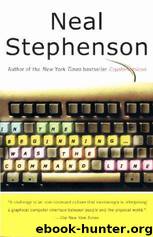In the beginning... was the command line by Neal Stephenson

Author:Neal Stephenson
Language: eng
Format: mobi
ISBN: 0380815931
Publisher: New York : Avon Books, c1999.
Published: 2009-02-09T14:27:08+00:00
THE ORAL TRADITION
Unix is hard to learn. The process of learning it is one of multiple small epiphanies. Typically you are just on the verge of inventing some necessary tool or utility when you realize that someone else has already invented it, and built it in, and this explains some odd file or directory or command that you have noticed but never really understood before.
For example, there is a command (a small program, part of the OS) called “whoami,” which enables you to ask the computer who it thinks you are. On a Unix machine, you are always logged in under some name—possibly even your own! What files you may work with, and what software you may use, depends on your identity. When I started out using Linux, I was on a nonnetworked machine in my basement, with only one user account, and so when I became aware of the whoami command it struck me as ludicrous. But once you are logged in as one person, you can temporarily switch over to a pseudonym in order to access different files. If your machine is on the Internet, you can log on to other computers, provided you have a user name and a password. At that point the distant machine becomes no different in practice from the one right in front of you. These changes in identity and location can easily become nested inside each other, many layers deep, even if you aren’t doing anything nefarious. Once you have forgotten who and where you are, the whoami command is indispensible. I use it all the time.
The file systems of Unix machines all have the same general structure. On your flimsy operating systems, you can create directories (folders) and give them names like Frodo or My Stuff and put them pretty much anywhere you like. But under Unix the highest level—the root—of the filesystem is always designated with the single character “/” and it always contains the same set of top-level directories:
Download
This site does not store any files on its server. We only index and link to content provided by other sites. Please contact the content providers to delete copyright contents if any and email us, we'll remove relevant links or contents immediately.
Test-Driven iOS Development with Swift 4 by Dominik Hauser(10312)
Filmora Efficient Editing by Alexander Zacharias(6711)
The Infinite Retina by Robert Scoble Irena Cronin(6210)
Learn Wireshark - Fundamentals of Wireshark. by Lisa Bock(4482)
Linux Device Driver Development Cookbook by Rodolfo Giometti(4041)
Edit Like a Pro with iMovie by Regit(3916)
Linux Administration Best Practices by Scott Alan Miller(2958)
Linux Command Line and Shell Scripting Techniques by Vedran Dakic & Jasmin Redzepagic(2908)
Mastering PowerShell Scripting - Fourth Edition by Chris Dent(2871)
Creative Projects for Rust Programmers by Carlo Milanesi(2709)
MCSA Windows Server 2016 Study Guide: Exam 70-740 by William Panek(2596)
Docker on Windows by Stoneman Elton(2392)
Kali Linux - An Ethical Hacker's Cookbook: End-to-end penetration testing solutions by Sharma Himanshu(2372)
Hands-On AWS Penetration Testing with Kali Linux by Karl Gilbert(2212)
Hands-On Linux for Architects by Denis Salamanca(2147)
Computers For Seniors For Dummies by Nancy C. Muir(2123)
Programming in C (4th Edition) (Developer's Library) by Stephen G. Kochan(2114)
The Old New Thing by Raymond Chen(2074)
Linux Kernel Debugging by Kaiwan N Billimoria(1830)
